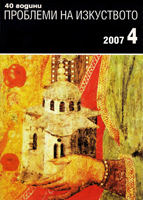Зографът монах Антоний Йоанов в изкуството от първата половина на XIX век
The Monk Artist Anthoniy Jovanov in the Art of the First Half of the 19th Century
Author(s): Viktorija Popovska-KorobarSubject(s): Cultural history
Published by: Институт за изследване на изкуствата, Българска академия на науките
Summary/Abstract: The zograph monk Anthoniy. lovanov was active in the ecclesiastic art, generally on the territory of the Debar-Kićevo Eparchy, around about 1810 to 1841. His earliest preserved signature dates to 1816 in the church of The Presentation of the Holy Virgin in the v. Doino Melnićani near Debar. On the Despotic icon of the patron saint of the church of St. Athanasios in the v. Oktisi near Struga, in the signature from 1817 he informs that he originates from Bitola. On the iconostasis of the church of The Dormition of the Holy Virgin in the v. Sobina in vicinity of Vranje (Serbia) in 1822 he introduces himself as a monk from "the monastery of Kićevo" (The Holy Virgin lmmaculate of Kićevo). However his affiliation with the monastery brotherhood has not been confirmed with other data. In the church of St. Nicholas - Gerakomia in Ohrid his preserved signature dates from 1830. The principal artistic and style features of the works of monk Anthoniy are: composition traced according to graphic prints, delicate drawing, rich and boisterous coloring, and use of Baroque and Rococo motives. In his earlier works the flesh tones are warmer. The forms softer, the colors are translucent d skillfully painted. Later on, dominating features are stiffness, firm and cold modeling which is accentuated by strong shades and gives contrast to the images. Distinct features are the Baroque panels in which the inscriptions are written and the Rococo motives used to delineate the painted portions, which are also used in adorning the thrones and frames. Sometimes the painted icon frame is adorned with a geometric ornament, thus linking Anthoniy’s work even closer to the graphic arts. He elaborately uses gold in the backdrop and the folds of the garments. Very often he paints accentuated clouds against a clear blue setting. The wood-carvings accompanying Anthoniy’s works (Royal Doors, Kemerias, Iconostasis Crosses and Arthophorias) are accomplished with skill and in a deep relief. These works are embellished with plants, birds and imaginary animals. We suppose these were made by the early known Mijak carvers or by Anthoniy himself. It is possible that at first he worked in the workshop of the monastery of St. John the Baptist at Bigor, where we can attribute to him the icons dating from 1810 and 1814. In the west bay of the catholicon of the this monastery, around about 1814 monk Anthoniy painted the fresco-icons of The Holy Virgin with Child and Jesus Christ Archpriest. In the 1820’s he most probably stayed in the Rila monastery, where he painted the Royal Doors of the parekklesion dedicated to St. Symeon and Sabbas of Serbia. The three-decade painting opus of monk Anthoniy shows a relative consistency in sense of style and artistic performance. His work is fully compatible to the artistic and ecclesiastic setting in Macedonia common for the beginning of the l9th century. He is the outcome of the developing process of fusion of Byzantine and West European ideas and forms,...
Journal: Проблеми на изкуството
- Issue Year: 2007
- Issue No: 4
- Page Range: 14-19
- Page Count: 6
- Content File-PDF

